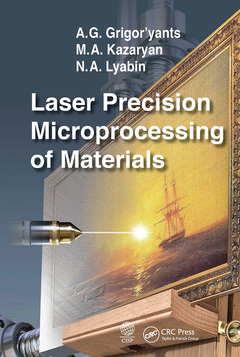Laser Precision Microprocessing of Materials
Auteurs : Grigor'yants A. G., Kazaryan M. A., Lyabin N. A.

This reference focuses on the current state of fundamental research and industrial achievements in the field of precision laser processing of a wide range of metal, semiconductor and dielectric materials. The possibilities of microprocessing by pulsed nanosecond laser radiation and copper vapor laser systems are analyzed. Design and operation principles, ways to increase their efficiency and reliability, and a series of modern automated technological installations are described. The work will be of interest to specialists, engineers, students and graduate students working and studying in the field of laser technology and optics, laser and information technology.
Introduction. Overview of the current state and development of pulsed copper vapor laser (CVL) and copper vapor laser processing systems (CVLPS). Possibilities of pulsed CVL and CVLPS for microprocessing of materials. A new generation of high-performance and durable industrial sealed active element pulsed CVL of the series "Coulomb" with a radiation power of 1-20 W and "Crystal" with a power of 30-100 W. Highly selective optical systems for the formation in CVL and CVLPS of single-beam radiation of diffraction quality and with stable parameters. Industrial technological CVL and CVLPS on the basis of a new generation of sealed active elements and new optical systems. Advanced Caravel automatic laser processing systems. Laser technologies of precision microprocessing of foil and thin sheet materials for electronic components. The use of industrial automatic laser processing systems "Caravel-1", "Caravel-1M", "Caravel-2" and "Caravel-2M" for the manufacture of precision parts of electronic components.
In 1970 Mishik Kazaryan graduated from the faculty of general and applied physics of Moscow Phycotechnical Institute in specialty "Optics and Spectroscopy." Since 1970 he has worked in P.N. Lebedev Physical Institute, currently at the Department of Luminescence as the leading researcher. In 1975 he defended his PhD-thesis and in 1989 Dr. Hab. thesis. Mishik Kazaryan was conferred the professor title. Currently, the main research fields of Prof. Kazaryan are related to the creation of powerful tunable lasers, the study of the basic physical mechanisms responsible for the implementation of the Kazaryan plasma 3D-effect, the construction of acousto-optical color television systems and devices, laser medicine, the study of the mechanisms of laser acceleration of microparticles, studies of light-induced phenomena at multiple dynamic light scattering, and electrically induced drift aquacomplexes in aqueous solutions, the development of new approaches to the problem of laser isotope separation, the development of new solutions to the problem of alternative and hydrogen energy, the development of new composite materials with a long luminescence, the synthesis of new nanomaterials. Prof. Kazaryan is one of the leading scientists working in the field of physics of gas lasers and active optical systems. He published a number of reports in leading scientific journals and encyclopedias, international patents, 11 books and 9 collections of selected articles in various international journals. He published more than 500 scientific papers. M.A.Kazaryan established a new method of exciting metal vapor lasers. He developed highly efficient lasers which are currently commercially available in Russia. For his work on the physics of lasers and optical systems, MA Kazarian together with team members were awarded the State Prize of the USSR in the field of science and technology for 1980. M.A.Kazarian together with A.M.Prokhorov, Yu.V. Gulyaev and Yu.A.Trutnev have developed many aspec
Date de parution : 08-2022
15.6x23.4 cm
Date de parution : 01-2019
15.6x23.4 cm
Thèmes de Laser Precision Microprocessing of Materials :
Mots-clés :
Average Radiation Power; Linear Synchronous Motor; precision laser processing; Peak Power Density; dielectric materials; Radiation Power; semiconductor materials; Bauman Moscow State Technical University; pulsed copper vapor laser; CVL; microprocessing foil materials; Power Consumption; thin sheet materials; UR; Copper Vapour; Discharge Channel; Diffraction Divergence; Diffraction Beam; Neon Buffer Gas; Buffer Gas; Concave Spherical Mirror; Models GL-201; Background Beam; Neon Pressure; Convex Mirror; Resonator Beam; Output Aperture; Polycrystalline Diamond; Lis; PA Mode; Coordinate Table



